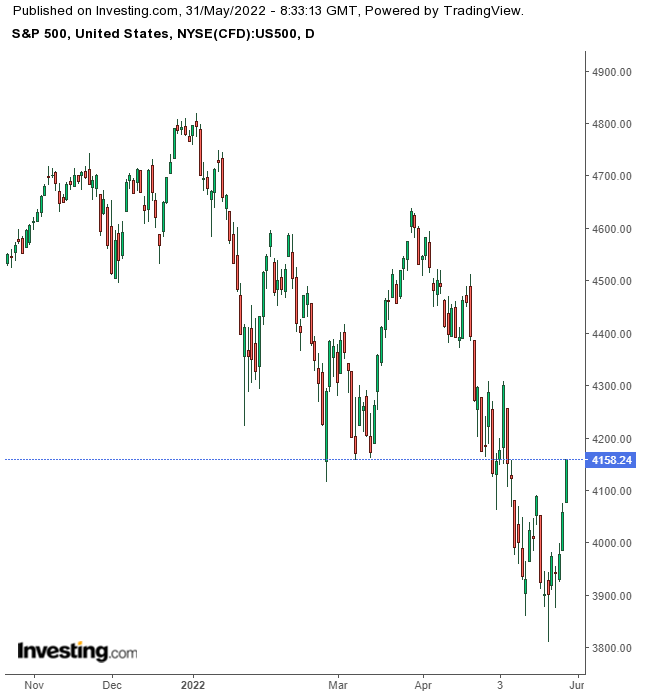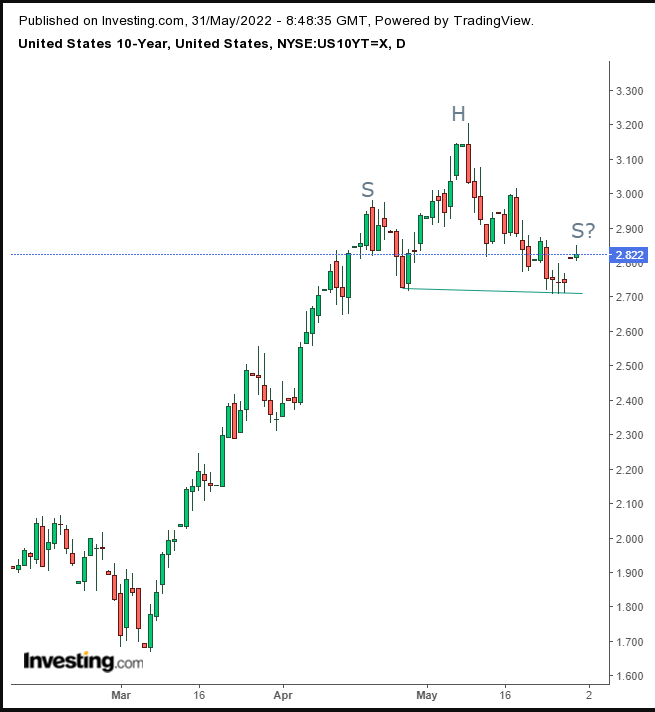- Oil prices rally as EU cuts Russian oil imports
- Unclear market narrative benefits bears
- Additional rate hikes expected
- The economy is good, and
- The economy is bad.
- US ISM Manufacturing PMI is published on Wednesday.
- New York Fed President John Williams and St. Louis Fed President James Bullard speak at separate events on Wednesday.
- On Wednesday, US JOLTs Job openings are reported.
- The MSCI Asia Pacific Index rose 0.2%
- The MSCI Emerging Markets Index rose 0.8%
- The euro fell 0.45% to $1.0729
- The Japanese yen rose 0.3% to 127.93 per dollar
- The British pound fell 0.4% to $1.2596
- Brent crude rose 1.3% to $119.48 a barrel
- Spot gold fell 0.4% to $1,849
Key Events
As Europe vowed to ban the purchase of most Russian oil supplies, rising prices of the commodity sent shockwaves across global financial markets on Tuesday.
Treasury yields surged as traders sold off bonds. Futures on the Dow Jones, S&P 500, NASDAQ 100, and Russell 2000 as well as European equities slumped.
Odds increased that the oil price rally would send inflation even higher thus forcing the US Federal Reserve to be more aggressive with its upcoming rate hikes. Gold fell slightly.
Global Financial Affairs
Following Europe's ban on Russian oil, which aims to cut 90% of imports from there into the bloc by the end of the year, the price of crude jumped, disrupting the recent stock market rally which saw the S&P 500, Dow Jones and NASDAQ move higher at the end of last week.
There seem to be two explanations for the reaction:
Positive economic developments naturally boost risk assets but it seems that negative data, which would allow the Fed to ease its planned monetary tightening, is also lifting risk assets.
We previously warned against a presumption that the bear market has bottomed just because of a single week's equity rally, irrespective of how robust the rebound was. In addition, we remind investors that bear markets are notorious for having some of the most substantial upside moves before slumping further.
The relationship paradigm between contracts on the major US indices resumed amid today's selloff. The tech-heavy NASDAQ 100, which represents growth stocks, outperformed, slipping the least, while the Dow Jones, standing for cyclicals and value, underperformed. While the S&P 500 was below the February/March lows.

European shares were under additional pressure from regional inflation data this morning. Record high inflation from the Eurozone followed news of a more extensive than anticipated jump in German consumer prices. Market observers were defensive, as traders expected the European Central Bank to take action. Also, French inflation jumped to a fresh record.
As a result, the STOXX 600 Index fell from its monthly high, halting four consecutive days of rallying. Technology stocks underperformed which is in line with the sector's performance in the US.
Yields on the 10-year Treasury note jumped as traders sold bonds in anticipation of higher interest rates.

Yields were forming a small H&S top. Technically, it's understandable that they will correct at this point, having reached the 2018 highs, but what would that mean fundamentally?
Typically, falling yields are bullish for stocks. Investors sell bonds to increase their holdings in equities. However, a monetary policy of rapid tightening is bearish for stocks as it could see investors sell off short-dated bonds in favor of new issues which offer higher payouts in order to keep up with the economy's rising interest rates.
The dollar moved higher, erasing Friday's losses.
Gold slipped after extending its advance to a second day.

The yellow metal may be developing a Falling Flag. While this formation tends to build amid lengthy rallies, the initial sharp climb, after bouncing above the uptrend line since the 2021 low, increases the chance of an upside breakout.
After surging to $32,000 on Monday, Bitcoin stumbled but recovered. The move broke the topside of a pennant which we thought would be bearish and as a result challenges our longer-term outlook for the moment.
